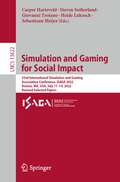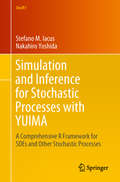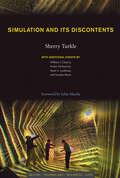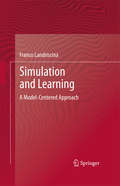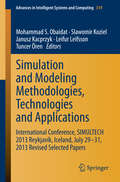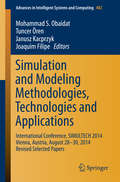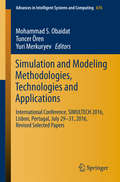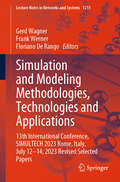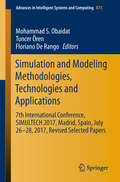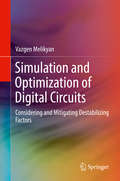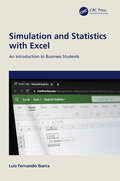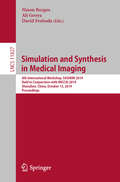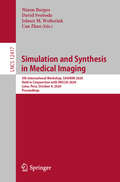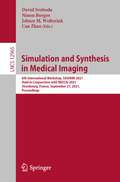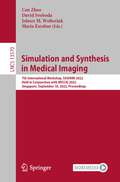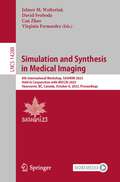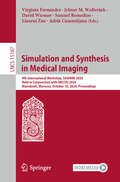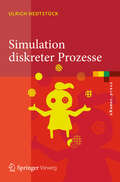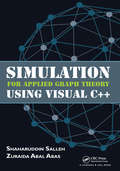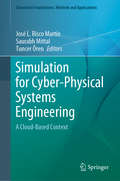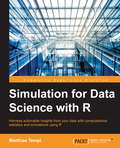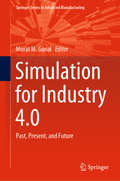- Table View
- List View
Simulation and Gaming for Social Impact: 53rd International Simulation and Gaming Association Conference, ISAGA 2022, Boston, MA, USA, July 11–14, 2022, Revised Selected Papers (Lecture Notes in Computer Science #13622)
by Casper Harteveld Sebastiaan Meijer Heide Lukosch Steven Sutherland Giovanni TroianoThis book constitutes revised selected papers from the 53rd International Simulation and Gaming Association Conference, ISAGA 2022, which took place in Boston, USA, during July 11–14, 2022.The 15 full papers presented in this volume were carefully reviewed and selected from 35 submissions. They were organized in topical sections named: education and training; resilience and sustainability; health; and social justice.
Simulation and Inference for Stochastic Processes with YUIMA: A Comprehensive R Framework for SDEs and Other Stochastic Processes (Use R!)
by Stefano M. Iacus Nakahiro YoshidaThe YUIMA package is the first comprehensive R framework based on S4 classes and methods which allows for the simulation of stochastic differential equations driven by Wiener process, Lévy processes or fractional Brownian motion, as well as CARMA, COGARCH, and Point processes. The package performs various central statistical analyses such as quasi maximum likelihood estimation, adaptive Bayes estimation, structural change point analysis, hypotheses testing, asynchronous covariance estimation, lead-lag estimation, LASSO model selection, and so on. YUIMA also supports stochastic numerical analysis by fast computation of the expected value of functionals of stochastic processes through automatic asymptotic expansion by means of the Malliavin calculus. All models can be multidimensional, multiparametric or non parametric.The book explains briefly the underlying theory for simulation and inference of several classes of stochastic processes and then presents both simulation experiments and applications to real data. Although these processes have been originally proposed in physics and more recently in finance, they are becoming popular also in biology due to the fact the time course experimental data are now available. The YUIMA package, available on CRAN, can be freely downloaded and this companion book will make the user able to start his or her analysis from the first page.
Simulation and Its Discontents
by Sherry TurkleOver the past twenty years, the technologies of simulation and visualization have changed our ways of looking at the world. In Simulation and Its Discontents,Sherry Turkle examines the now dominant medium of our working lives and finds that simulation has become its own sensibility. We hear it in Turkle's description of architecture students who no longer design with a pencil, of science and engineering students who admit that computer models seem more "real" than experiments in physical laboratories. Echoing architect Louis Kahn's famous question, "What does a brick want?", Turkle asks, "What does simulation want?" Simulations want, even demand, immersion, and the benefits are clear. Architects create buildings unimaginable before virtual design; scientists determine the structure of molecules by manipulating them in virtual space; physicians practice anatomy on digitized humans. But immersed in simulation, we are vulnerable. There are losses as well as gains. Older scientists describe a younger generation as "drunk with code." Young scientists, engineers, and designers, full citizens of the virtual, scramble to capture their mentors' tacit knowledge of buildings and bodies. From both sides of a generational divide, there is anxiety that in simulation, something important is slipping away. Turkle's examination of simulation over the past twenty years is followed by four in-depth investigations of contemporary simulation culture: space exploration, oceanography, architecture, and biology. Simplicity: Design, Technology, Business, Life, edited by John Maeda
Simulation and Its Discontents (Simplicity: Design, Technology, Business, Life)
by Sherry TurkleHow the simulation and visualization technologies so pervasive in science, engineering, and design have changed our way of seeing the world.Over the past twenty years, the technologies of simulation and visualization have changed our ways of looking at the world. In Simulation and Its Discontents, Sherry Turkle examines the now dominant medium of our working lives and finds that simulation has become its own sensibility. We hear it in Turkle's description of architecture students who no longer design with a pencil, of science and engineering students who admit that computer models seem more “real” than experiments in physical laboratories.Echoing architect Louis Kahn's famous question, “What does a brick want?”, Turkle asks, “What does simulation want?” Simulations want, even demand, immersion, and the benefits are clear. Architects create buildings unimaginable before virtual design; scientists determine the structure of molecules by manipulating them in virtual space; physicians practice anatomy on digitized humans. But immersed in simulation, we are vulnerable. There are losses as well as gains. Older scientists describe a younger generation as “drunk with code.” Young scientists, engineers, and designers, full citizens of the virtual, scramble to capture their mentors' tacit knowledge of buildings and bodies. From both sides of a generational divide, there is anxiety that in simulation, something important is slipping away. Turkle's examination of simulation over the past twenty years is followed by four in-depth investigations of contemporary simulation culture: space exploration, oceanography, architecture, and biology.
Simulation and Learning
by Franco LandriscinaThe main idea of this book is that to comprehend the instructional potential of simulation and to design effective simulation-based learning environments, one has to consider both what happens inside the computer and inside the students' minds. The framework adopted to do this is model-centered learning, in which simulation is seen as particularly effective when learning requires a restructuring of the individual mental models of the students, as in conceptual change. Mental models are by themeselves simulations, and thus simulation models can extend our biological capacity to carry out simulative reasoning. For this reason, recent approaches in cognitive science like embodied cognition and the extended mind hypothesis are also considered in the book.. A conceptual model called the "epistemic simulation cycle" is proposed as a blueprint for the comprehension of the cognitive activies involved in simulation-based learning and for instructional design.
Simulation and Learning: A Model-Centered Approach
by Franco LandriscinaThe main idea of this book is that to comprehend the instructional potential of simulation and to design effective simulation-based learning environments, one has to consider both what happens inside the computer and inside the students' minds. The framework adopted to do this is model-centered learning, in which simulation is seen as particularly effective when learning requires a restructuring of the individual mental models of the students, as in conceptual change. Mental models are by themeselves simulations, and thus simulation models can extend our biological capacity to carry out simulative reasoning. For this reason, recent approaches in cognitive science like embodied cognition and the extended mind hypothesis are also considered in the book.. A conceptual model called the "epistemic simulation cycle" is proposed as a blueprint for the comprehension of the cognitive activies involved in simulation-based learning and for instructional design.
Simulation and Modeling Methodologies, Technologies and Applications
by Leifur Leifsson Slawomir Koziel Mohammad S. Obaidat Janusz Kacprzyk Tuncer ÖrenThis book includes extended and revised versions of a set of selected papers from the 3rd International Conference on Simulation and Modeling Methodologies, Technologies and Applications (SIMULTECH 2013) which was co-organized by the Reykjavik University (RU) and sponsored by the Institute for Systems and Technologies of Information, Control and Communication (INSTICC). SIMULTECH 2013 was held in cooperation with the ACM SIGSIM - Special Interest Group (SIG) on SImulation and Modeling (SIM), Movimento Italiano Modellazione e Simulazione (MIMOS) and AIS Special Interest Group on Modeling and Simulation (AIS SIGMAS) and technically co-sponsored by the Society for Modeling & Simulation International (SCS), Liophant Simulation, Simulation Team and International Federation for Information Processing (IFIP). This proceedings brings together researchers, engineers, applied mathematicians and practitioners working in the advances and applications in the field of system simulation.
Simulation and Modeling Methodologies, Technologies and Applications
by Mohammad S. Obaidat Joaquim Filipe Janusz Kacprzyk Tuncer ÖrenThepresent book includes a set of selected extended papers from the 5thInternational Conference on Simulation and Modeling Methodologies, Technologiesand Applications (SIMULTECH 2015), held in Colmar, France, from 21 to 23 July2015. The conference brought together researchers, engineers and practitionersinterested in methodologies and applications of modeling and simulation. Newand innovative solutions are reported in this book. SIMULTECH 2015 received 102submissions, from 36 countries, in all continents. After a double blind paperreview performed by the Program Committee, 19% were accepted as full papers andthus selected for oral presentation. Additional papers were accepted as shortpapers and posters. A further selection was made after the Conference, basedalso on the assessment of presentation quality and audience interest, so thatthis book includes the extended and revised versions of the very best papers ofSIMULTECH 2015. Commitment to high quality standards is a major concern of SIMULTECHthat will be maintained in the next editions, considering not only thestringent paper acceptance ratios but also the quality of the programcommittee, keynote lectures, participation level and logistics.
Simulation and Modeling Methodologies, Technologies and Applications
by Yuri Merkuryev Mohammad S. Obaidat Tuncer ÖrenThis book includes extended and revised versions of a set of selected papers from the 2012 International Conference on Simulation and Modeling Methodologies, Technologies and Applications (SIMULTECH 2012) which was sponsored by the Institute for Systems and Technologies of Information, Control and Communication (INSTICC) and held in Rome, Italy. SIMULTECH 2012 was technically co-sponsored by the Society for Modeling & Simulation International (SCS), GDR I3, Lionphant Simulation, Simulation Team and IFIP and held in cooperation with AIS Special Interest Group of Modeling and Simulation (AIS SIGMAS) and the Movimento Italiano Modellazione e Simulazione (MIMOS).
Simulation and Modeling Methodologies, Technologies and Applications: 13th International Conference, SIMULTECH 2023 Rome, Italy, July 12-14, 2023 Revised Selected Papers (Lecture Notes in Networks and Systems #1211)
by Gerd Wagner Frank Werner Floriano De RangoThis book includes a set of selected best extended papers from the 13th International Conference on Simulation and Modeling Methodologies, Technologies and Applications (SIMULTECH 2023), that was held in Rome, Italy, from July 12 to 14. The conference brought together researchers, engineers, and practitioners interested in methodologies and applications of modeling and simulation. New and innovative solutions are reported in this book. A selection was made after the conference, based also on the conference chairs assessment, reviewers’ assessment, quality of presentation, and audience interest, so that this book includes the extended and revised versions of the very best papers of the conference. New and innovative solutions are reported in this book.
Simulation and Modeling Methodologies, Technologies and Applications: 7th International Conference, SIMULTECH 2017 Madrid, Spain, July 26–28, 2017 Revised Selected Papers (Advances in Intelligent Systems and Computing #873)
by Mohammad S. Obaidat Tuncer Ören Floriano De RangoThis book highlights a set of selected, revised and extended papers from the 7th International Conference on Simulation and Modeling Methodologies, Technologies and Applications (SIMULTECH 2017), held in Madrid, Spain, on July 26 to 28, 2017. The conference brought together researchers, engineers and practitioners whose work involves methodologies in and applications of modeling and simulation. The papers showcased here represent the very best papers from the Conference, and report on a broad range of new and innovative solutions.
Simulation and Modeling Methodologies, Technologies and Applications: 8th International Conference, SIMULTECH 2018, Porto, Portugal, July 29-31, 2018, Revised Selected Papers (Advances in Intelligent Systems and Computing #947)
by Mohammad S. Obaidat Tuncer Ören Floriano De RangoThis book includes a selection of papers from the 8th International Conference on Simulation and Modeling Methodologies, Technologies and Applications (SIMULTECH 2018), held in Porto, Portugal, from July 29 to 31, 2018. Presenting new and innovative solutions, the book features extended and revised versions of the very best conference papers as well as the latest research in the field.
Simulation and Optimization of Digital Circuits: Considering And Mitigating Destabilizing Factors
by Vazgen MelikyanThis book describes new, fuzzy logic-based mathematical apparatus, which enable readers to work with continuous variables, while implementing whole circuit simulations with speed, similar to gate-level simulators and accuracy, similar to circuit-level simulators. The author demonstrates newly developed principles of digital integrated circuit simulation and optimization that take into consideration various external and internal destabilizing factors, influencing the operation of digital ICs. The discussion includes factors including radiation, ambient temperature, electromagnetic fields, and climatic conditions, as well as non-ideality of interconnects and power rails.
Simulation and Statistics with Excel: An Introduction to Business Students
by Luis Fernando IbarraThe use of simulation techniques has increased in importance in recent history, and simulation activities are an important resource for advanced preparation for the organization and execution of events. When formal mathematics is not enough, simulation may be the only option capable of approximating solutions. Simulation and Statistics with Excel: An Introduction to Business Students offers a non-rigorous and practical tour of the simulation procedure on computers, using a versatile and accessible resource, the Microsoft Excel spreadsheet. This book covers the concepts essential to understanding the basic principles and approaches of statistical simulation, allowing for the study of complex systems. Aimed at students in business and operational research beginning to use simulation as an instrument for understanding existing or proposed processes, this book will lay solid foundations in understanding simulation experimentation.Key Features: Provides a basis to understand the approaches and principles of simulator experiments. Uses a universal and easily accessible resource. Introduces simple examples to teach the fundamentals of simulation.
Simulation and Synthesis in Medical Imaging: 4th International Workshop, SASHIMI 2019, Held in Conjunction with MICCAI 2019, Shenzhen, China, October 13, 2019, Proceedings (Lecture Notes in Computer Science #11827)
by Ali Gooya Ninon Burgos David SvobodaThis book constitutes the refereed proceedings of the 4th International Workshop on Simulation and Synthesis in Medical Imaging, SASHIMI 2019, held in conjunction with MICCAI 2019, in Shenzhen, China, in October 2019.The 16 full papers presented were carefully reviewed and selected from 21 submissions. The contributions span the following broad categories in alignment with the initial call-for-papers: methods based on generative models or adversarial learning for MRI/CT/PET/microscopy image synthesis, image super resolution, and several applications of image synthesis and simulation for data augmentation, segmentation or lesion detection.
Simulation and Synthesis in Medical Imaging: 5th International Workshop, SASHIMI 2020, Held in Conjunction with MICCAI 2020, Lima, Peru, October 4, 2020, Proceedings (Lecture Notes in Computer Science #12417)
by Ninon Burgos David Svoboda Jelmer M. Wolterink Can ZhaoThis book constitutes the refereed proceedings of the 5th International Workshop on Simulation and Synthesis in Medical Imaging, SASHIMI 2020, held in conjunction with MICCAI 2020, in Lima, Peru, in October 2020. The 19 full papers presented were carefully reviewed and selected from 27 submissions. The contributions span the following broad categories in alignment with the initial call-for-papers: methods based on generative models or adversarial learning for MRI/CT/PET/microscopy image synthesis, and several applications of image synthesis and simulation for data augmentation, image enhancement or segmentation.
Simulation and Synthesis in Medical Imaging: 6th International Workshop, SASHIMI 2021, Held in Conjunction with MICCAI 2021, Strasbourg, France, September 27, 2021, Proceedings (Lecture Notes in Computer Science #12965)
by Ninon Burgos David Svoboda Jelmer M. Wolterink Can ZhaoThis book constitutes the refereed proceedings of the 6th International Workshop on Simulation and Synthesis in Medical Imaging, SASHIMI 2021, held in conjunction with MICCAI 2021, in Strasbourg, France, in September 2021.*The 14 full papers presented were carefully reviewed and selected from 18 submissions. The contributions span the following broad categories in alignment with the initial call-for-papers: methods based on generative models or adversarial learning for MRI/CT/ microscopy image synthesis, and several applications of image synthesis and simulation for data augmentation, image enhancement, or segmentation. *The workshop was held virtually.
Simulation and Synthesis in Medical Imaging: 7th International Workshop, SASHIMI 2022, Held in Conjunction with MICCAI 2022, Singapore, September 18, 2022, Proceedings (Lecture Notes in Computer Science #13570)
by David Svoboda Jelmer M. Wolterink Can Zhao Maria EscobarThis book constitutes the refereed proceedings of the 7th International Workshop on Simulation and Synthesis in Medical Imaging, SASHIMI 2022, held in conjunction with MICCAI 2022, in Singapore, Singapore in September 2022.
Simulation and Synthesis in Medical Imaging: 8th International Workshop, SASHIMI 2023, Held in Conjunction with MICCAI 2023, Vancouver, BC, Canada, October 8, 2023, Proceedings (Lecture Notes in Computer Science #14288)
by David Svoboda Jelmer M. Wolterink Can Zhao Virginia FernandezThis book constitutes the refereed proceedings of the 8th International Workshop on Simulation and Synthesis in Medical Imaging, SASHIMI 2023, held in conjunction with MICCAI 2023, in Vancouver, Canada, in October 2023.The 13 full papers included in this book were carefully reviewed and selected from 16 submissions. They span a wide range of topics relevant to SASHIMI, and reflect recent developments in methods for segmentation, image-to-image translation, super-resolution, and image synthesis. Applications include MRI imaging, echocardiography, PET, and digital pathology.
Simulation and Synthesis in Medical Imaging: 9th International Workshop, SASHIMI 2024, Held in Conjunction with MICCAI 2024, Marrakesh, Morocco, October 10, 2024, Proceedings (Lecture Notes in Computer Science #15187)
by David Wiesner Jelmer M. Wolterink Virginia Fernandez Lianrui Zuo Samuel Remedios Adrià CasamitjanaThis book constitutes the refereed proceedings of the 9th International Workshop on Simulation and Synthesis in Medical Imaging, SASHIMI 2024, held in conjunction with the 27th International conference on Medical Image Computing and Computer Assisted Intervention, MICCAI 2024, in Marrakesh, Morocco in October 2024. The 19 papers included in this book were carefully reviewed and selected from 32 submissions. They focus on recent developments in methods for image-to-image translation, image synthesis, biophysical modelling, super-resolution and image segmentation and classification.
Simulation diskreter Prozesse: Methoden und Anwendungen
by Ulrich HedtstückDieses Buch führt in die Simulation diskreter Prozesse ein. Typische Anwendungsbeispiele sind Fertigungsprozesse, Strassenverkehrssituationen, Menschenströme und Geschäftsprozesse. Der Autor vermittelt die grundlegende ereignisorientierte Simulation sowie deren programmiertechnische Realisierung. Anhand vieler Beispiele wird die Lösung spezieller Detailprobleme mit grundlegendem Charakter gezeigt. Die durch die Optimierung von Geschäftsprozessen entstandenen neuen Herausforderungen bezüglich der Simulation bilden einen Schwerpunkt der Darstellung, ein separater Teil ist den theoretischen Grundlagen gewidmet. Lernziel des Buches ist die Fähigkeit, diskrete Prozesse mit den passenden Mitteln zu modellieren und dazu eine Simulationssoftware zu entwerfen bzw. die Mechanismen bestehender Simulationssoftware so zu begreifen, dass sie gewinnbringend eingesetzt werden kann. Die wichtigen Programmstrukturen sind in Form von Pseudocode dargestellt und dadurch völlig unabhängig von einer Programmiersprache oder Spezialsoftware. Damit ist das Buch für eine breite Leserschaft geeignet.
Simulation for Applied Graph Theory Using Visual C++
by Shaharuddin Salleh Zuraida Abal AbasThe tool for visualization is Microsoft Visual C++. This popular software has the standard C++ combined with the Microsoft Foundation Classes (MFC) libraries for Windows visualization. This book explains how to create a graph interactively, solve problems in graph theory with minimum number of C++ codes, and provide friendly interfaces that makes learning the topics an interesting one. Each topic in the book comes with working Visual C++ codes which can easily be adapted as solutions to various problems in science and engineering.
Simulation for Cyber-Physical Systems Engineering: A Cloud-Based Context (Simulation Foundations, Methods and Applications)
by Tuncer Ören Saurabh Mittal José L. Risco MartínThis comprehensive book examines a range of examples, prepared by a diverse group of academic and industry practitioners, which demonstrate how cloud-based simulation is being extensively used across many disciplines, including cyber-physical systems engineering. This book is a compendium of the state of the art in cloud-based simulation that instructors can use to inform the next generation. It highlights the underlying infrastructure, modeling paradigms, and simulation methodologies that can be brought to bear to develop the next generation of systems for a highly connected society. Such systems, aptly termed cyber-physical systems (CPS), are now widely used in e.g. transportation systems, smart grids, connected vehicles, industrial production systems, healthcare, education, and defense. Modeling and simulation (M&S), along with big data technologies, are at the forefront of complex systems engineering research. The disciplines of cloud-based simulation and CPS engineering are evolving at a rapid pace, but are not optimally supporting each other’s advancement. This book brings together these two communities, which already serve multi-disciplinary applications. It provides an overview of the simulation technologies landscape, and of infrastructure pertaining to the use of cloud-based environments for CPS engineering. It covers the engineering, design, and application of cloud simulation technologies and infrastructures applicable for CPS engineering. The contributions share valuable lessons learned from developing real-time embedded and robotic systems deployed through cloud-based infrastructures for application in CPS engineering and IoT-enabled society. The coverage incorporates cloud-based M&S as a medium for facilitating CPS engineering and governance, and elaborates on available cloud-based M&S technologies and their impacts on specific aspects of CPS engineering.
Simulation for Data Science with R
by Matthias TemplHarness actionable insights from your data with computational statistics and simulations using R About This Book * Learn five different simulation techniques (Monte Carlo, Discrete Event Simulation, System Dynamics, Agent-Based Modeling, and Resampling) in-depth using real-world case studies * A unique book that teaches you the essential and fundamental concepts in statistical modeling and simulation * This book is written by the Amazon best-selling author of Learning Statistics (The easier Way) with R Who This Book Is For This book is for users who are familiar with computational methods. If you want to learn about the advanced features of R, including the computer-intense Monte-Carlo methods as well as computational tools for statistical simulation, then this book is for you. Good knowledge of R programming is assumed/required. What You Will Learn * The book aims to explore advanced R features to simulate data to extract insights from your data. * Get to know the advanced features of R including high-performance computing and advanced data manipulation * See random number simulation used to simulate distributions, data sets, and populations * Simulate close-to-reality populations as the basis for agent-based micro-, model- and design-based simulations * Applications to design statistical solutions with R for solving scientific and real world problems * Comprehensive coverage of several R statistical packages like boot, simPop, VIM, data.table, dplyr, parallel, StatDA, simecol, simecolModels, deSolve and many more. In Detail Data Science with R aims to teach you how to begin performing data science tasks by taking advantage of Rs powerful ecosystem of packages. R being the most widely used programming language when used with data science can be a powerful combination to solve complexities involved with varied data sets in the real world. The book will provide a computational and methodological framework for statistical simulation to the users. Through this book, you will get in grips with the software environment R. After getting to know the background of popular methods in the area of computational statistics, you will see some applications in R to better understand the methods as well as gaining experience of working with real-world data and real-world problems. This book helps uncover the large-scale patterns in complex systems where interdependencies and variation are critical. An effective simulation is driven by data generating processes that accurately reflect real physical populations. You will learn how to plan and structure a simulation project to aid in the decision-making process as well as the presentation of results. By the end of this book, you reader will get in touch with the software environment R. After getting background on popular methods in the area, you will see applications in R to better understand the methods as well as to gain experience when working on real-world data and real-world problems. Style and approach This book takes a practical, hands-on approach to explain the statistical computing methods, gives advice on the usage of these methods, and provides computational tools to help you solve common problems in statistical simulation and computer-intense methods.
Simulation for Industry 4.0: Past, Present, and Future (Springer Series in Advanced Manufacturing)
by Murat M. GunalThe book shows how simulation’s long history and close ties to industry since the third industrial revolution have led to its growing importance in Industry 4.0. The book emphasises the role of simulation in the new industrial revolution, and its application as a key aspect of making Industry 4.0 a reality – and thus achieving the complete digitisation of manufacturing and business. It presents various perspectives on simulation and demonstrates its applications, from augmented or virtual reality to process engineering, and from quantum computing to intelligent management. Simulation for Industry 4.0 is a guide and milestone for the simulation community, as well as those readers working to achieve the goals of Industry 4.0. The connections between simulation and Industry 4.0 drawn here will be of interest not only to beginners, but also to practitioners and researchers as a point of departure in the subject, and as a guide for new lines of study.
